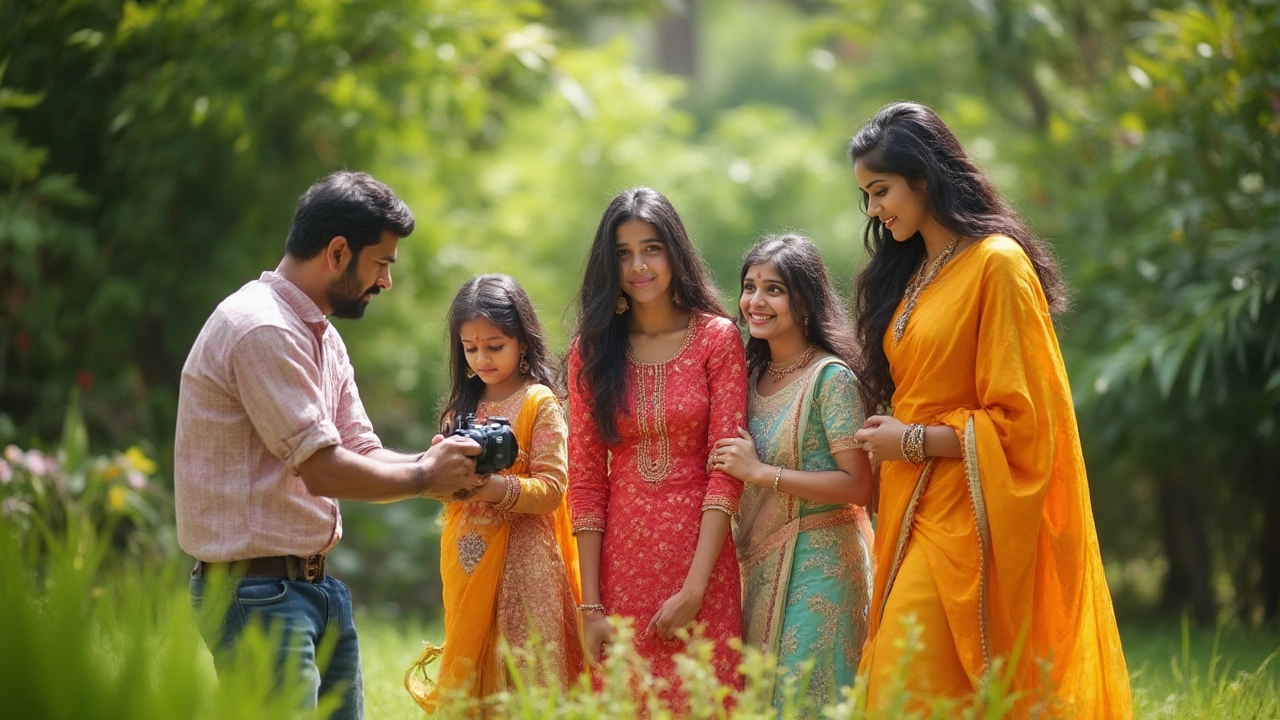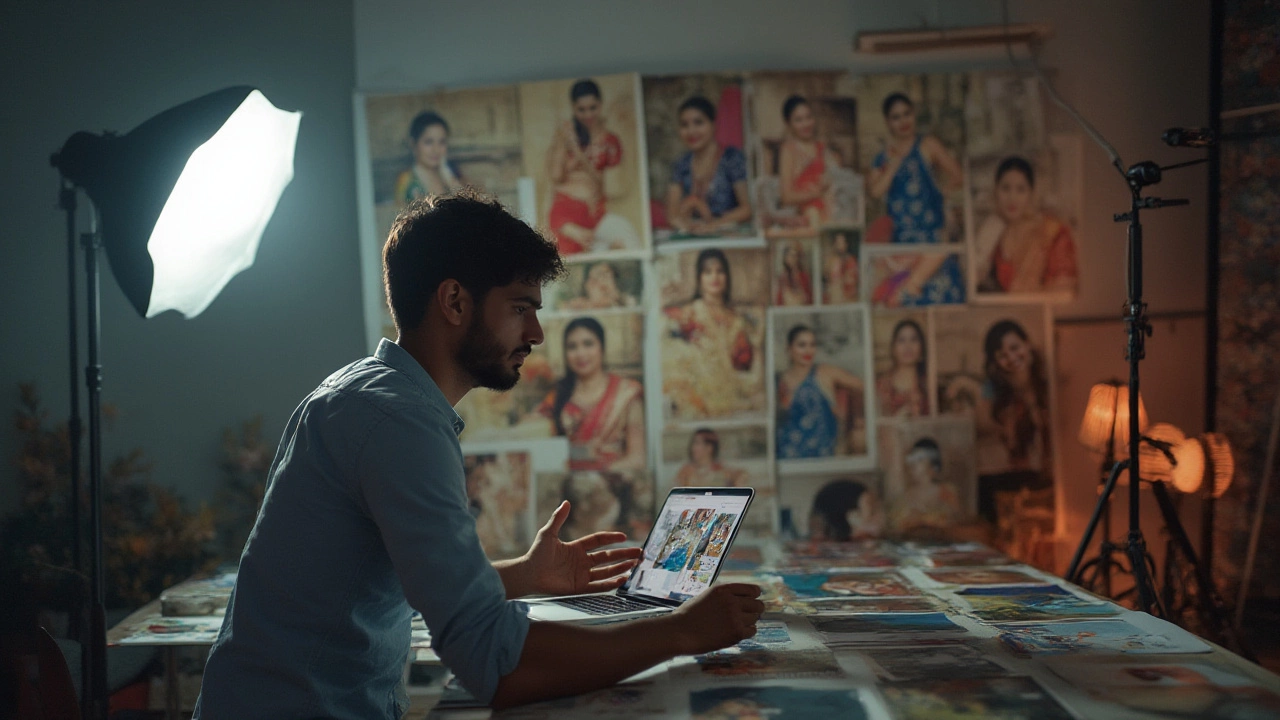How Many Photos Do You Get From a 1 Hour Photoshoot? Expectations Explained
 Jul, 15 2025
Jul, 15 2025
You book a photographer for an hour, smile on cue, change a shirt or two, and after all that, the big question lingers: how many decent photos will you actually get? It’s not like a wedding shoot, with endless snaps, but it’s more than just a handful of quick selfies. Modern clients expect clarity, not guesswork, yet every photographer seems to have a different answer. Some promise you the moon, others keep it minimal. So what gives? Why does the range of final images from a one-hour photoshoot stretch from as little as a dozen to well over a hundred?
What Impacts the Number of Photos Delivered?
There isn’t a single magic number, because several factors subtly, and not so subtly, shape the total shots you get from an hour-long session. Anyone who tells you every 1 hour shoot produces a set number hasn’t seen the wild variety out there. Type of shoot is the main one: headshots? Expect fewer, highly curated photos. Events? You’ll get a higher stack since photographers shoot in bursts to catch every laugh and blink. The setting matters—studio work often focuses on quality not quantity, while outdoor sessions throw in variety and sometimes more snaps.
Experience plays a big part. Seasoned photographers shoot with intention—fewer throwaways, less fidgeting with setup, smoother direction. That means fewer wasted frames, and usually a much more efficient shoot. Compare that with a beginner, who might overshoot in an attempt to guarantee something decent, but ends up with a bloated gallery of near-duplicates.
Editing style changes things drastically. Some shooters deliver only the best edited images, cutting out errors or awkward moments, while others hand over a much larger semi-polished chunk. Nail the brief, and clients tend to be happier with a set of, say, 40 killer photos than wading through 100 nearly-identical ones. I remember a client in Birmingham once getting 70 finished images from her corporate branding shoot. She was thrilled—until she realized 40 of those were just versions of herself blinking. Always better to go for variety, not just volume.
Shooting style and gear also shift the numbers. Mirrorless cameras make it so easy to fire off hundreds of frames, but that doesn’t mean you need them all. If your photographer works with film (yes, still popular for portraits!), expect a far, far lower number. Also, certain genres demand a particular approach: fashion includes multiple outfit changes and setups, lifestyle shoots may include background adjustments and props, while family sessions sometimes move at the speed of a distracted toddler or a mischievous dog (like my Max, who thinks every shoot is an hour-long game of hide and seek).
Lastly, the goal of the session shapes output. Are you chasing one killer profile picture, or a gallery telling a story for your business? Feeling comfortable on camera also goes a long way—relaxed sessions mean fewer anxious blinks and more keepers per hour! Don’t forget, the more shot variety and less time tweaking with lights or posing, the higher your delivered photo count climbs.
Realistic Photo Counts for Different Shoot Types
Maybe you’ve seen guides promising “at least 100 high-res images from a one-hour shoot”—sounds amazing, but that’s only half the story. Let’s break it down by session type, because what you get from an event is not what you’ll get from a solo portrait.
| Shoot Type | Typical Delivered Photos (1 hour) |
|---|---|
| Individual Headshots | 10 - 20 |
| Couple/Engagement | 30 - 50 |
| Family/Group | 35 - 60 |
| Event/Party | 50 - 120 |
| Fashion/Lifestyle | 25 - 70 |
| Product | 15 - 40 |
Headshots are slow and meticulous. Expect a handful of beautifully lit, well-retouched final photos. A fast-paced birthday bash in a Birmingham park? The count might triple, with photographers capturing candid reactions, kids racing around, and joyous, chaotic moments. Lifestyle branding sessions find a sweet spot: not too many, not too few, with lots of variety but a keen eye on quality. Product shoots go even lower, because each item might need careful setup, styling, and controlled angles—sometimes it can take 10 minutes for a single frame if the client wants perfection.
If your photographer promises 80+ perfect images from a headshot hour, ask how much time is being put into retouching and variety. Sometimes, you get all the unedited images as ‘previews,’ but only a select set get proper attention. Here’s a quote from Sue Bryce, a world-renowned portrait photographer:
"Quality is never an accident—it is always the result of intelligent effort."
This rings true for both the shooter and client. Sometimes fewer, highly curated images create much more impact—and customer satisfaction—than flooding a folder with every press of the shutter.

What Actually Happens During a One Hour Shoot?
People imagine an hour-long shoot as 60 minutes of constant clicking, but a lot goes into it behind the scenes. When clients arrive, there’s usually a bit of chatter to break the ice—nothing stiffens a smile more than a camera pointed at your face in total silence. The first few frames often serve as warmups, especially if you don’t love being photographed (never underestimate the power of a casual chat about dogs to get people relaxed—Max is my secret weapon for this!).
For studio work, you might start with a few classic poses, slowly building confidence and introducing some creative lighting or backdrops as the session warms up. Each pose might get a dozen shots with slight tweaks to expression, angle, and focus. That’s why photographers often shoot 150 to 300 images in an hour—but only a fraction of those ever leave the editing room. It’s not because the rest are ‘bad’, but small details—a blink here, a missed focus there—mean only the best make the cut. Experienced photographers work to maximize variety within each brief, so you’re not just getting version after version of the same pose.
Location shoots add time for walking between backgrounds, maybe a quick outfit change, adjusting camera settings for changing light, and guiding clients into natural, flattering stances. If kids or pets are involved, add a few more minutes for wrangling—nobody wants staged portraits where the Labrador looks like he’s plotting an escape. Some sessions, especially with families, unfold in a documentary style, snapping spontaneous moments that show off everyone’s real personalities.
After the session wraps, the ‘invisible’ work starts. Photographers cull the images, ditching duplicates, out-of-focus frames, or the ones where someone’s making an odd face. That culling process is where the delivery count is really decided. Editing takes time—color tweaking, minor retouching, cropping, straightening—so most photographers deliver only the best, not the bulk. That’s why the number you see at the end usually reflects care, not just raw productivity.
Sorting, editing, and renaming the files can chew up more time than the actual shoot itself, so don’t be surprised when your photographer says you’ll see your gallery in a week or two. Fancy AI tools are making that part faster these days, but for delicate work (like removing random dog fur from everyone’s trousers) humans still beat computers.
How to Get the Most Out of Your Photo Shoot
If you really want to maximize your 1 hour photoshoot, prep in advance and communicate clearly. Tell your photographer what vibe or style you want—classic, lifestyle, editorial, candid fun? Some folks dream of moody black and white, others want every shot bursting with colour. Show a few photo examples if you can, just to avoid any confusion. The clearer you are, the less time gets wasted on guesswork.
Work out logistics: location, time of day (golden hour light is a photographer’s best friend), and whether anyone will need hair or makeup touch-ups. Wardrobe tweaks make a huge difference, so bring a spare shirt or scarf to add variety. If you’re nervous, bring a prop—a football, favourite book, or even your dog Max equivalent (extra marks if he actually follows commands). The more relaxed you feel, the more authentic your photos will be, and the higher your success rate per snap.
Ask your photographer about their average delivery. Pros should be able to tell you honestly, with numbers backed by recent galleries, not just vague promises. If you’re expecting social media content, say so, since you’ll likely need more variety. For traditional portrait albums or gifts, you might want fewer images, but of a much higher level of editing.
Don’t forget about editing preferences. Some photographers deliver high-end retouching on only a few images (think magazine cover style), while others include light edits on the bulk but charge extra for heavy touch-ups. Get clear on what’s included—and what’ll cost you more. It’s not just about number, it’s about what you can actually use. There’s nothing worse than getting 80 images with weird colour tones or heavy-handed smoothing.
Finally, keep realistic expectations. If you’re after both quantity and quality, be flexible. Big events with lots of action will net you a huge batch, but classic studio portraits? Fewer, but sharper and more refined. Be wary of anyone promising crazy-high numbers with perfect editing included—that’s either too good to be true, or your photographer is burning out behind the scenes.
If your dog steals the show, don’t be surprised if he ends up in half the gallery—sometimes, the unexpected stars of a session are what make your photos truly memorable.